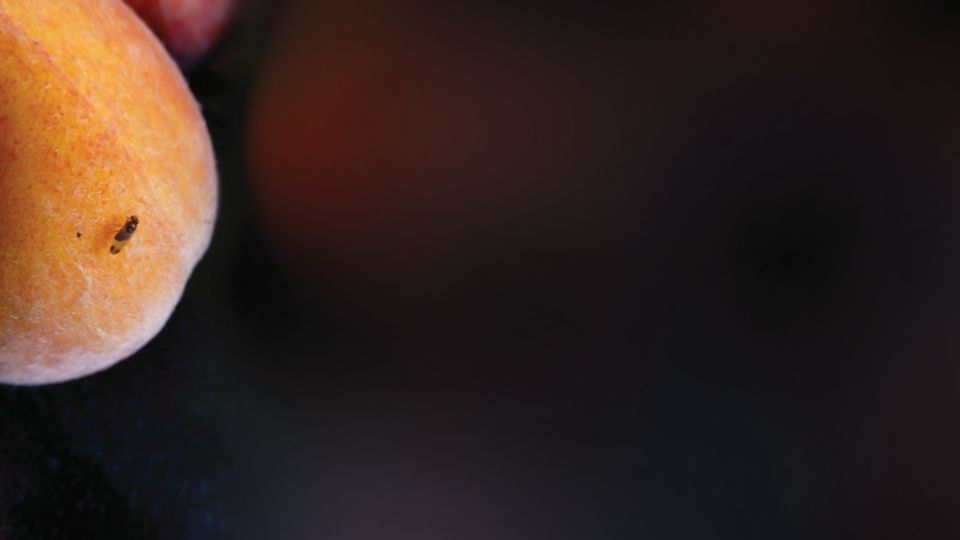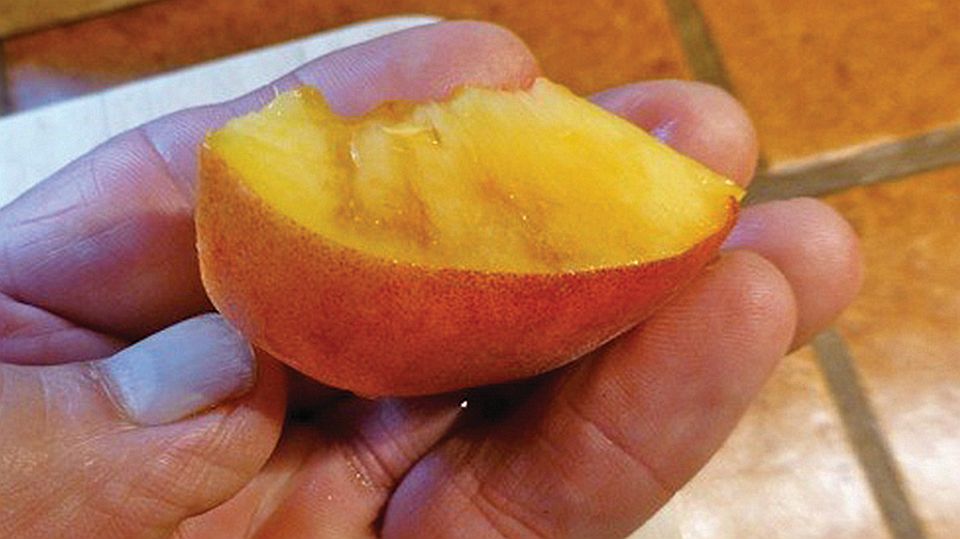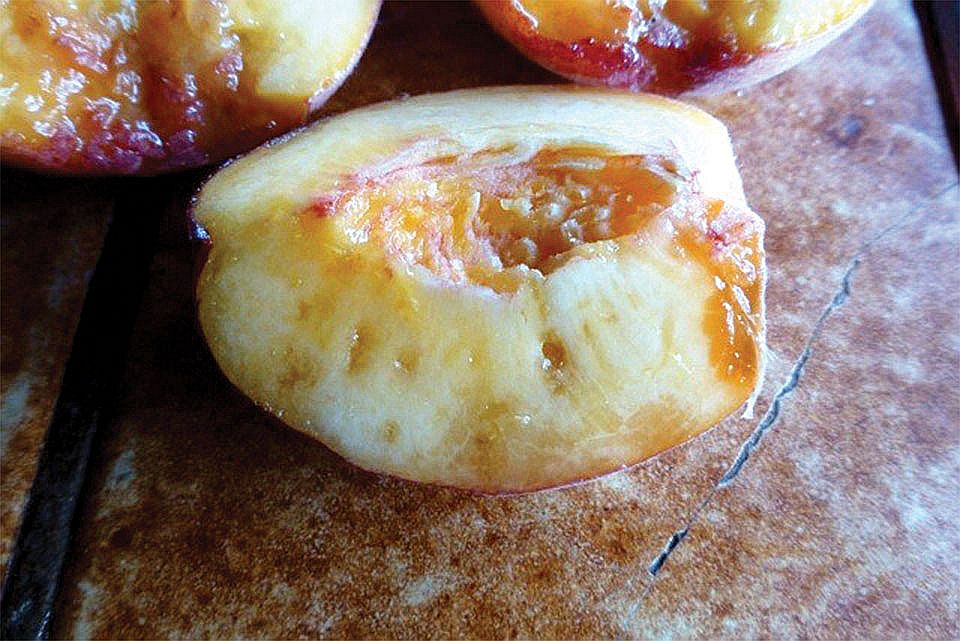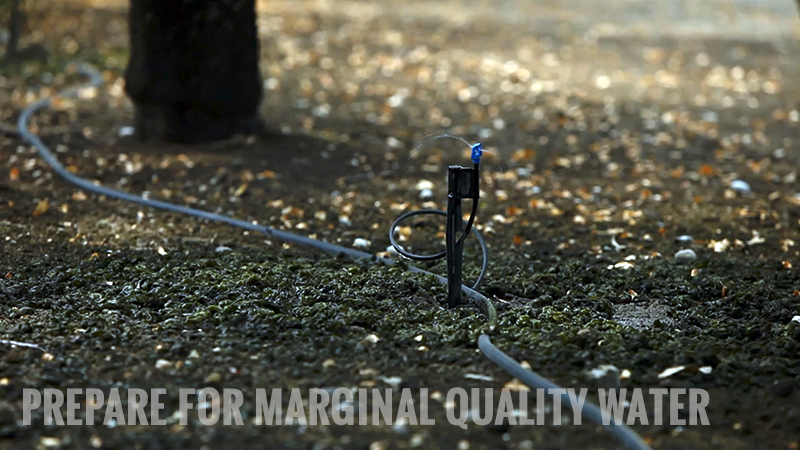Spotted Wing Drosophila is an Old Pest, but New Threat to Peaches

Spotted wing drosophila is photographed on a fresh peach. (Photo: Richard Ossolinski)
When it comes to crops spotted wing drosophila (SWD) favor, small, soft fruits usually come to mind. But conversations on the AppleCrop listserv, have extended to SWD targeting intact peaches which is something entirely new for some regions of the country.
The mild winter of 2016-17 may have something to do with the early emergence of SWD this year, researchers are still learning a lot about the overwintering habits of this invasive pest.

A peach that did not show any evidence of compromise on the outside shows evidence of tunneling on the inside. (Photo: Richard Ossolinski)
“We think the cool, wet spring and cloudy, rainy early summer favored oviposition in all fruit, not just fruit in shaded and dense canopies, and contributed to SWD population build up,” says Julie Carroll, New York State IPM’s fruit coordinator.
For some growers, like Kevin VerSnyder of VerSnyder Orchards in Lake Leelanau, MI, the challenge with SWD control in places like Northwest Michigan has to do with the large amount of tart cherries grown in the Traverse City area, which compounds any control strategies.
VerSnyder says he originally thought the damage he saw on his peaches was from birds.
“I’ve now learned when the peaches get tree-ripe, they are susceptible to SWD because I keep finding their larvae where I see the rotten spots,” says VerSnyder. “I don’t believe the birds are doing the damage either. These rotten spots were created by the pest.”
New Threat This Season
This is similar to the peach damage that grower Richard Ossolinski of Gouldsboro, ME, contacted Glen Koehler of the University of Maine Cooperative Extension’s Pest Management Office in Orono, ME, about. Koehler says the peaches were “at perfect ripeness when they were attacked.”
“Harvesting of absolutely clean, unblemished peaches revealed the telltale tunneling of SWD,” Ossolinski says. “And any dead ripe fruit whose surface either revealed or didn’t reveal even the slightest evidence of compromise looked damaged when cut.”
Ossolinski says SWD has been in his neck of the woods — Southeast coast of Maine — for about six years. The pest has always attacked plums with already damaged skins. However, this season has been different.
“This year we’ve seen them on compromised apples, pears, tomatoes, and on apparently ripe but uncompromised peaches,” he says.
What is Their Deal?
While growers and researchers alike are learning the habits of SWD and how they feed on crops, but many with experience with SWD say it’s more likely you’ll see the pest attack damaged, rotten, or dropped peaches.
“The big question is, are they laying eggs in otherwise sound peaches and nectarines? I want to say yes, but only if those become what I would call over-ripe on the trees,” Jon Clements, a tree fruit specialist working for the University of Massachusetts, Amherst’s Extension Fruit Program says.
In Carroll’s area, SWD infestations in peaches have been in ripe and soft fruit or even dropped fruit.

“And any dead ripe fruit whose surface either revealed or didn’t reveal even the slightest evidence of compromise looked damaged when cut,” says grower Richard Ossolinski.
(Photo: Richard Ossolinski)
“There are cases of SWD ovipositing in peaches that have no evidence of a break — no split pit, no prior wound — but that are just deliciously ripe on the tree,” she says. “Perhaps the place where the stem meets the fruit can provide an entry point.”
Best Practices
With peaches, VerSnyder says control is more of a challenge in part due to preharvest intervals (PHI).
“Get some border insecticide sprays on around the outside of an orchard where the pest is coming in from,” he says. “The challenge for the peach grower is an insecticide with a very short PHI because we pick every two to three days. Entrust is organic but still has a seven-day PHI,” he says.
Clements says peach growers also need to keep up with harvest. “Don’t let fruit get too soft on the tree,” he says.
Koehler notes that sanitation recommendations call for burying drops and damaged fruit at least 2 feet deep in the ground.
“Just tossing them into a compost pile may not prevent emerging adults from finding their way out,” he says.
Carroll says growers should also use cold chain as a line of defense, much like with berries.
“Fruit was going into a cooler at about 34°F immediately after harvest,” she says. “This slows or kills the development of SWD eggs and larvae.”
And, above all, Koehler says growers need to understand that if SWD traps indicate its presence in other crops, consider peaches vulnerable.
“From now on my recommendation will be that peaches, like raspberries, strawberries, blueberries etc., need protection if SWD are above threshold and ripening fruit is present,” he says.










